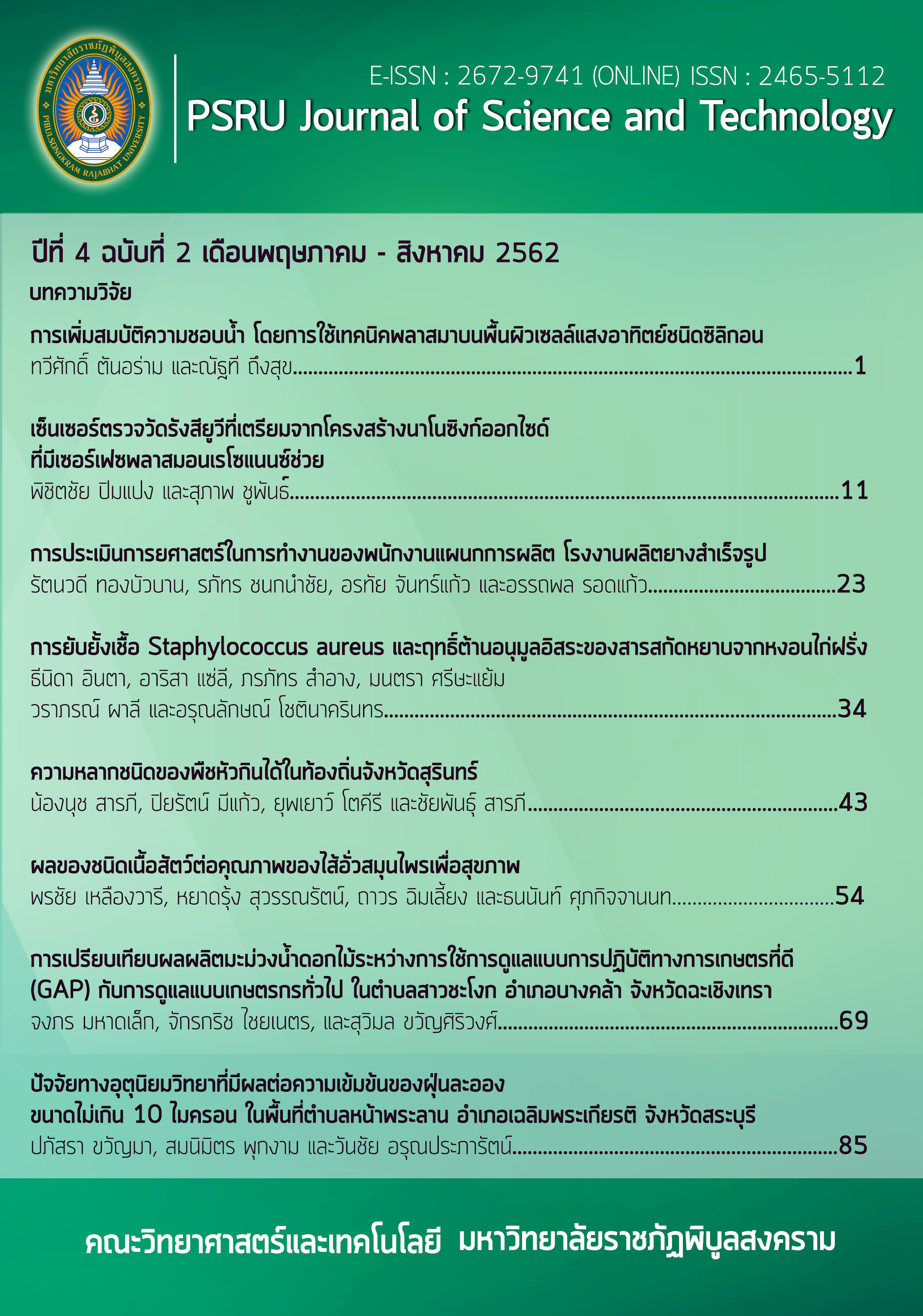PRODUCTIVITY COMPARISON OF NAM DOKMAI USING GOOD AGRICULTURAL PRACTICE (GAP) AND GENERAL AGRICULTURAL EXECUTE IN SAO CHA-NGOK, BANGKHLA, CHACHOENGSAO
Keywords:
Nam Dokmai mango, good agricultural practice (GAP), general agricultural executeAbstract
The objectives of this research were to study the care systems of Nam Dokmai Mangoes using General Agricultural Practice and Good Agricultural Practice (GAP), to compare the productivity such as quantity, quality and expenses, and to disseminate this research by training workshop for agriculturist grow mangoes in Sao Cha-Ngok subdistrict. Three gardens of the Nam Dokmai mango cultivated area (12 trees/garden) were selected as experimental plot and control plot (General Agricultural Execute). The yield of mangoes from experimental plot (GAP) was 1,062 fruits, total weight 346.60 kgs, average fruit weight 323.70 grams whereas The yield of mangoes from control plots was 685 fruits, total weight 201.24 kgs, average fruit weight 282.11 grams. Therefore, the different yield was 377 fruits, total weight 145.36 kgs. The sales of Nam Dokmai mangoes from experimental plot (GAP) and control plot were 17,290 baht and 7,043 baht, respectively. The caring cost of the experimental plot was higher than that of control plot about 4,362 baht. The profit of the experimental plot was higher than that of control plot about 5,884 baht. Therefore, if the agriculturist cultivated Nam Dokmai mangoes 5 acres, the profit would get more than 78,461 baht. Because if thinking in economics, the value that can be increased from cost reduction from chemical fertilizers that will remain in the soil and the value of the carbon bag used to wrap the mango can be reused (80%). From the training workshop to disseminate the knowledge of care systems Nam Dokmai mango for 29 agriculturists in SaoCha-Ngok, the agriculturist opinions showed that the assessment results had a good level of average opinion (4.05 ± 0.60) and the participants can apply the knowledge gained to take care mango garden that had the highest level (4.56 ± 0.51). The results concluded that the care system Nam Dokmai mangoes using GAP had the higher yield and higher quality than that using general agricultural practice. Because it is the result of care system by step-by-step care such as use effective fertilizer, good pest control, wrapping prevent the destruction of the disease which they are different from general agricultural practice that take care only a few steps, put chemical fertilizer or manure for some year, protect disease and insect in available period. There were reasons don’t want to lose more money and don’t sure the output product. This research shows that if agriculturists using GAP system, they will be able to increase yields in both quantity and quality and increased revenue.
References
พิภพ ปราบณรงค์. (2536). ผลกระทบจากการทำนากุ้งต่อสมบัติทางเคมีของดินในอำเภอระโนด จังหวัดสงขลา. (วิทยานิพนธ์วิทยาศาสตร์มหาบัณฑิต). มหาวิทยาลัยสงขลานครินทร์. กรุงเทพฯ
วรรณภา เสนาดี. (2559). พื้นที่ 10 ไร่ ก็ทำมะม่วงส่งออกได้ด้วยการรวมกลุ่ม. วารสารเคหะการเกษตร, 40(5), 107-110.
วีรภัทรา ดอนไพรอ่อน, รัตนา นาคสิงห์, วันดี วัฒนชัยยิ่งเจริญ และ ธัชคณิน จงจิตวิมล. (2561). ความหลากชนิดของมดในสวนมะม่วง จังหวัดพิษณุโลก. PSRU Journal of Science and Technology, 3(1), 1-8.
สำนักงานเกษตรจังหวัดฉะเชิงเทรา. (2560). สรุปข้อมูลการปลูกมะม่วงจังหวัดฉะเชิงเทรา ปี พ.ศ.2557- 2558. สืบค้นเมื่อ 10 มกราคม 2560, จาก http://www.chacho-engsao.doae.go.th/
สํานักงานคณะกรรมการพัฒนาการเศรษฐกิจและสังคมแห่งชาติ. (2555). ภาวะสังคมไทยไตรมาสสี่ และภาพรวมปี 2554. 10(1) กุมภาพันธ์ 2555. สืบค้นเมื่อ 1 มิถุนายน 2559, จาก http://www.nesdb.go.th/
สำนักงานมาตรฐานสินค้าเกษตรและอาหารแห่งชาติ กระทรวงเกษตรและสหกรณ์. (2556). การปฏิบัติทางการเกษตรที่ดีสำหรับพืชอาหาร (Good Agricultural Practices: GAP). สืบค้นเมื่อ 20 มิถุนายน 2560 จาก https://www.acfs.go.th/standard/download/GAPfood%20crop.pdf
สุจิกา ฉิมอ่อง. (2557). เจตคติของเกษตรกรผู้ปลูกมะม่วงน้ำดอกไม้ที่มีต่อมาตรฐานเกษตรดีที่เหมาะสม (GAP) และการผลิตแบบมีสัญญาซื้อขายในอำเภอกุยบุรี จังหวัดประจวบคีรีขันธ์. วารสารวิชาการ Veridian E-Journal, 7(1), 561-585.
สุจิตรา ชูเกิด, ทิพย์ทิวา สัมพันธมิตร และ วิชุดา เกตุใหม่. (2555). การตกค้างของสารเคมีจากการทำนา. เอกสารประชุมวิชาการ. การประชุมทางวิชาการ พะเยาวิจัย ครั้งที่ 1. มหาวิทยาลัยพะเยา.
Downloads
Published
How to Cite
Issue
Section
License
กองบรรณาธิการขอสงวนสิทธิ์ในการปรับปรุงแก้ไขตัวอักษรและคำสะกดต่างๆ ที่ไม่ถูกต้อง และต้นฉบับที่ได้รับการตีพิมพ์ในวารสาร PSRU Journal of Science and Technology ถือเป็นกรรมสิทธิ์ของคณะวิทยาศาสตร์และเทคโนโลยี มหาวิทยาลัยราชภัฏพิบูลสงคราม และ
ผลการพิจารณาคัดเลือกบทความตีพิมพ์ในวารสารให้ถือมติของกองบรรณาธิการเป็นที่สิ้นสุด







